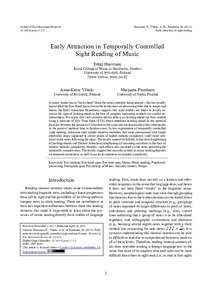Early attraction in temporally controlled sight reading of music
Erkki Huovinen; Anna-Kaisa Ylitalo; Marjaana Puurtinen
https://urn.fi/URN:NBN:fi-fe2021042719121
Tiivistelmä
A music reader has to “look ahead” from the notes currently being played—this has usually been called the Eye-Hand Span. Given the restrictions on processing time due to tempo and meter, the Early Attraction Hypothesis suggests that sight readers are likely to locally increase the span of looking ahead in the face of complex upcoming symbols (or symbol relationships). We argue that such stimulus-driven effects on looking ahead are best studied using a measure of Eye-Time Span (ETS) which redefines looking ahead as the metrical distance between the position of a fixation in the score and another position that corresponds to the point of metrical time at fixation onset. In two experiments of temporally controlled sight reading, musicians read simple stepwise melodies that were interspersed with larger intervallic skips, supposed to create points of higher melodic complexity (and visual salience) at the notes following the skips. The results support both Early Attraction (lengthening of looking ahead) and Distant Attraction (lengthening of incoming saccades) in the face of relative melodic complexity. Notably, such effects also occurred on the notes preceding the nominally complex ones. The results suggest that saccadic control in music reading depends on temporal restrictions as well as on local variations in stimulus complexity.
Kokoelmat
- Rinnakkaistallenteet [27094]
